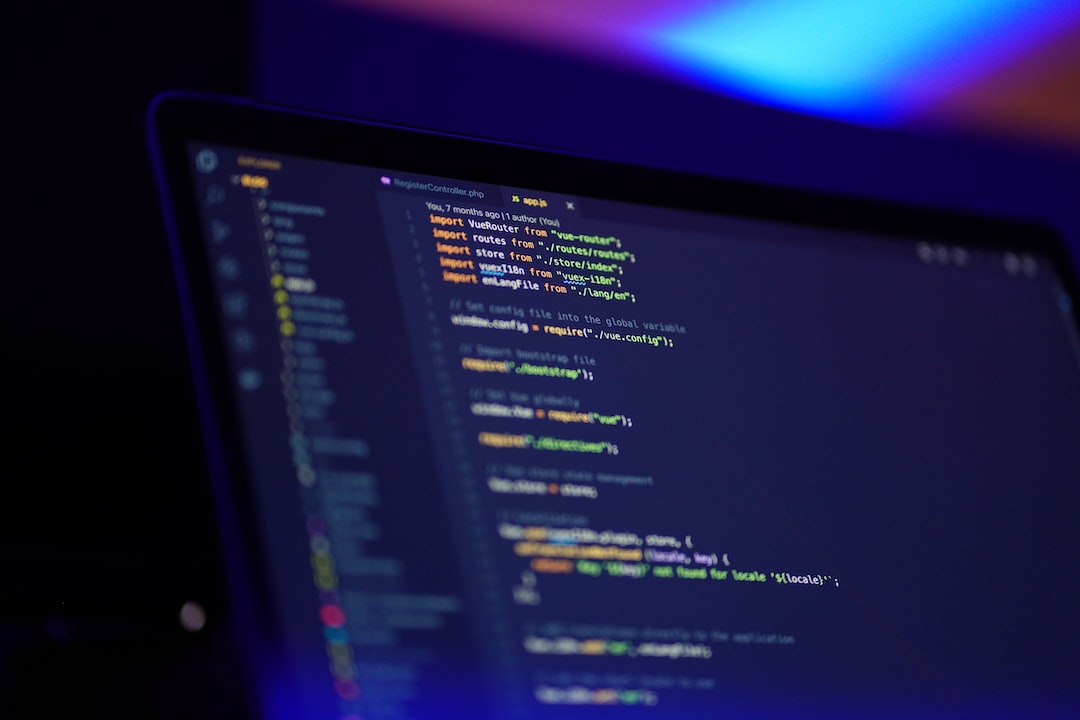Welcome to our blog post on best practices for writing clean and efficient code! In today’s fast-paced world of software development, it is crucial to write code that is not only functional but also easy to read, understand, and maintain. This is where the importance of following coding conventions and utilizing efficient programming techniques comes into play.
In this blog post, we will explore seven key strategies that can help you write cleaner and more efficient code. By implementing these practices, not only will your code become more maintainable, but it will also improve the overall performance of your applications. So, let’s dive in and discover how we can elevate our coding skills to the next level!
Use descriptive variable and function names
When it comes to writing clean and maintainable code, one of the key factors is the use of descriptive variable and function names. This might seem like a small detail, but it can have a significant impact on the readability and understandability of your code.
By using descriptive names, you make your code self-explanatory and easier to comprehend for both yourself and others who might read or work on your code in the future. Instead of using generic names like “var1” or “function2”, strive to choose names that accurately describe the purpose and functionality of the variable or function.
For example, instead of using a variable name like “x”, consider using something more descriptive like “numberOfStudents” or “currentTemperature”. This simple change can make a world of difference when you revisit your code months or even years later, as it eliminates the need to decipher the meaning behind obscure variable names.
Similarly, when defining functions, make sure to choose names that clearly convey their intended purpose. A function named “calculateAverage” is much more informative than simply naming it “calculate”. By using descriptive function names, you make your code more self-documenting, reducing the need for excessive comments to explain what the function does.
Furthermore, it is essential to be consistent in your naming conventions throughout your codebase. This consistency helps create a sense of cohesion and makes it easier for others to navigate and understand your code.
To ensure descriptive variable and function names, consider the following tips:
1. Use meaningful and descriptive names that accurately reflect the purpose of the variable or function.
2. Avoid using abbreviations or acronyms unless they are widely known and understood within your codebase.
3. Be mindful of the scope of your variables and functions, and choose names that reflect their intended usage.
4. Use camel case or underscore notation to separate words in your variable and function names, depending on the coding conventions you follow.
By following these guidelines, you not only enhance the readability and maintainability of your code but also contribute to creating a more collaborative and efficient development environment.
Remember, the devil is in the details, and taking the time to choose descriptive names can go a long way in improving the overall quality of your code. So, let’s strive to write code that is clear, concise, and easy to understand for ourselves and those who come after us.
Remember, the devil is in the details, and taking the time to choose descriptive names can go a long way in improving the overall quality of your code.
Follow consistent coding conventions
Consistency is key when it comes to writing clean and maintainable code. Following consistent coding conventions is a must for any developer looking to improve the readability and understandability of their codebase.
One important aspect of coding conventions is the naming of variables, functions, and classes. Descriptive and meaningful names can go a long way in making your code self-explanatory. By choosing names that accurately reflect the purpose and functionality of your code, you not only make it easier for yourself to understand your own code later on, but also for other developers who might be working on the same project.
It’s common practice to use camel case or snake case when naming variables and functions. Camel case involves starting each word with a capital letter except the first, whereas snake case uses underscores to separate words. Whichever convention you choose, stick to it consistently throughout your codebase. This will prevent confusion and make your code more approachable for others.
Additionally, it’s crucial to maintain a consistent indentation style and formatting in your code. Whether you prefer to use spaces or tabs for indentation, make sure to use the same style consistently across your project. Consistent indentation enhances code readability and helps avoid potential errors caused by inconsistent spacing.
Another aspect of coding conventions is the proper use of comments. Adding comments to your code can greatly aid in understanding the logic behind complex functions or algorithms. When writing comments, make sure to use a clear and concise language that explains the purpose of the code. It’s also recommended to use inline comments sparingly and only when necessary, as excessive comments can clutter the code and reduce readability.
Lastly, consider adopting a style guide or using a linter tool that enforces consistent coding conventions. Style guides, such as the widely used JavaScript Standard Style, provide a set of rules and best practices to follow. These guides help maintain consistency across different projects and make it easier for developers to collaborate.
Following consistent coding conventions not only improves the readability of your code but also enhances its maintainability. By adhering to a set of conventions, you make your code more adaptable and easier to understand for yourself and others. So, take the time to establish and follow consistent coding conventions in your projects, and you’ll reap the benefits in the long run.
It’s common practice to use camel case or snake case when naming variables and functions.
Minimize global variables and use local variables instead
When it comes to writing clean and efficient code, minimizing the use of global variables is crucial. Global variables are accessible from anywhere within your code, making it difficult to track and manage their values. This can lead to unexpected side effects and bugs that are hard to debug.
Instead, it’s best to use local variables within the scope of specific functions or blocks of code. Local variables are only accessible within their respective scopes, which helps to encapsulate their values and prevent unintended modifications.
By using local variables, you can achieve better code organization and maintainability. It becomes easier to understand and reason about your code since you know exactly where variables are defined and used.
Another advantage of using local variables is that they are usually faster to access than global variables. Accessing a local variable involves retrieving its value directly from memory, while accessing a global variable requires searching through a larger scope, which can be slower.
Moreover, local variables are more memory-efficient as they occupy memory only for the duration of their scope. Global variables, on the other hand, persist throughout the execution of your program, consuming memory even when they are not needed.
By minimizing the use of global variables and utilizing local variables instead, you can improve both the performance and readability of your code. It allows for better modularity and reduces the likelihood of conflicts or unintended side effects.
In situations where sharing data between different parts of your code is necessary, consider passing variables as function arguments or using return values to transfer data. This promotes a more structured and predictable flow of information within your program.
Remember, the goal is to write code that is not only functional but also maintainable and scalable. By adopting the practice of minimizing global variables and favoring local variables, you are taking a step towards creating code that is easier to understand, debug, and enhance in the future.
Moreover, local variables are more memory-efficient as they occupy memory only for the duration of their scope.
Avoid Unnecessary Repetition and Optimize Code Execution
When writing code, it is important to keep in mind that repetition is not always a good thing. Repeating the same lines of code multiple times can not only make your code longer and harder to read, but it can also lead to potential errors and bugs. Therefore, it is crucial to avoid unnecessary repetition and optimize the execution of your code.
One way to achieve this is by using loops instead of writing the same lines of code over and over again. Loops allow you to perform a certain action multiple times without having to duplicate code. Whether it’s a for loop, a while loop, or a do-while loop, using them appropriately can significantly reduce repetition and make your code more efficient.
Furthermore, take advantage of functions or methods to encapsulate repetitive code and make it reusable. By creating functions that perform specific tasks, you can call them whenever necessary, instead of rewriting the same lines of code again and again. This not only saves time but also improves the maintainability of your code.
Another aspect of avoiding repetition is through the use of conditionals. Instead of writing separate blocks of code for different scenarios, you can use if-else statements to handle multiple conditions in a more concise manner. This allows you to streamline your code and avoid unnecessary repetition while still achieving the desired outcomes.
In addition to avoiding repetition, optimizing code execution is equally important. This involves finding ways to make your code run more efficiently and faster. One technique is to minimize the number of operations performed within loops. For example, if you have a loop that performs a calculation, try to move that calculation outside the loop if possible. This can significantly improve the performance of your code, especially when dealing with large data sets.
Another way to optimize code execution is by avoiding unnecessary computations. Before performing any operation, consider if it is truly necessary. Sometimes, you may be able to skip certain computations or implement shortcuts that achieve the same result with fewer steps. This not only improves the speed of your code but also reduces resource consumption.
Lastly, make use of built-in functions or libraries that provide optimized algorithms for common tasks. These libraries are often extensively tested and optimized for performance, so leveraging them can save you time and effort. Additionally, consider using appropriate data structures that are efficient for the specific problem you are solving. Choosing the right data structure can greatly impact the execution time of your code.
Avoiding unnecessary repetition and optimizing code execution are crucial elements of writing efficient and maintainable code. By using loops, functions, conditionals, and optimized algorithms, you can reduce repetition, improve performance, and make your code more readable and scalable. Remember, writing clean and optimized code not only benefits you but also makes the lives of other developers who may work with or maintain your code much easier. So, embrace these practices and strive for code excellence!
Furthermore, take advantage of functions or methods to encapsulate repetitive code and make it reusable.
Use Appropriate Data Structures and Algorithms
When it comes to writing efficient and effective code, the choice of data structures and algorithms can greatly impact the performance of your program. By selecting the appropriate data structures and algorithms for your specific problem, you can optimize execution time and ensure that your code runs smoothly.
Data structures such as arrays, linked lists, trees, stacks, and queues offer different advantages and trade-offs. Understanding the characteristics and operations of these data structures can help you make informed decisions when solving problems. For example, if you need constant-time access to elements and don’t require dynamic resizing, an array might be the most suitable choice. On the other hand, if you frequently need to insert or delete elements in the middle of a collection, a linked list might be more efficient.
Similarly, the choice of algorithms to solve a problem can greatly impact performance. Algorithms like sorting, searching, and graph traversal have different time complexities, and selecting the most appropriate one for your specific situation can significantly improve efficiency. For example, if you have a large collection of data that needs to be sorted, using a quicksort algorithm might be more efficient than a bubble sort or insertion sort.
Additionally, understanding algorithmic complexity, commonly expressed as Big O notation, can help you evaluate the efficiency of different algorithms and make informed decisions. By analyzing the time and space complexity of an algorithm, you can estimate how it will scale with larger inputs and determine whether it meets the performance requirements of your application.
Furthermore, leveraging existing libraries and frameworks that provide optimized data structures and algorithms can save you time and effort. Many programming languages offer built-in data structures and algorithms that have been optimized for performance and reliability. By utilizing these resources, you can benefit from the collective knowledge and experience of the programming community.
In summary, using appropriate data structures and algorithms is crucial for writing efficient and optimized code. By carefully selecting the most suitable data structures and algorithms for your specific problem, analyzing their complexity, and leveraging existing libraries, you can ensure that your code performs well and meets the performance requirements of your application. So, take the time to explore and understand different data structures and algorithms – your code will thank you later!
In summary, using appropriate data structures and algorithms is crucial for writing efficient and optimized code.
Conclusion
In conclusion, adopting good coding practices can significantly improve the quality and efficiency of your code. By using descriptive variable and function names, you make your code more readable and easier to understand, facilitating collaboration with other developers and enhancing maintenance in the long run.
Consistency in coding conventions is also crucial. It ensures that your code is uniform and coherent, regardless of who is writing it. This consistency helps in maintaining code readability and avoiding confusion, making it easier to debug and modify your code when necessary.
Minimizing the use of global variables and favoring local variables instead is an essential practice. It reduces the chance of unintended variable collisions and makes your code more modular, enhancing its reusability and maintainability.
Avoiding unnecessary repetition and optimizing code execution is vital for improving performance. By eliminating redundant code and finding more efficient ways to accomplish tasks, you can enhance the speed and efficiency of your code, ultimately providing a better user experience.
Choosing appropriate data structures and algorithms is key to achieving optimal performance and scalability. Understanding the strengths and weaknesses of different data structures and algorithms allows you to select the most suitable ones for your specific use case, ensuring that your code performs efficiently even with large datasets or complex operations.
By implementing these best practices, you can write cleaner, more efficient, and maintainable code. While it may require extra effort initially, the long-term benefits are worth it. Your code will be more readable, less prone to errors, and easier to maintain and scale as your project grows.
In the end, coding is not just about getting things done; it’s about doing them in the best possible way. With the right practices, you can elevate your coding skills and deliver high-quality solutions that stand the test of time. So, let’s strive for excellence in our coding practices and create a better coding world together!





